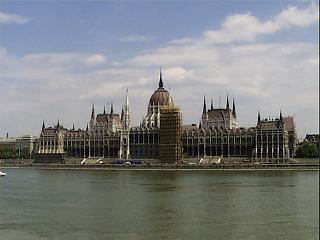

(above) The Parliament building in Budapest
Introduction
Hungary, formerly in the Eastern Bloc dominated by the Soviet Union, yet always wasone of the most "western" states in the confederation. Hungary a country so often occupied and subdivided, throughout history. The Turks were here from the mid C16 to the late C17, then the Austrians (Hapsburgs) became the rulers of the country. Following the first world war large areas of Hungary were ceded to form parts of other countries, Slovakia, Romania for instance. The Magyar have risen against Turks, Austrians and USSR, to exert themselves as the proud nation they are and were cruelly put down. The end of Communism in Hungary, unlike its many neighbours, came peaceably and without bloodshed.
Today Hungary is looking to become part of the European Union, Budapest appears like most large international cities and the unmistakable marks of capitalism e.g. the signs of the rival cola or burger companies are everywhere. Outside of the capital, things are less so, although the amount of building work on the edges of towns and cities is impossible to miss as western supermarkets - Tesco, Auchan and others - move in.
The reason for such a proud national identity must in part be due to an impossible language! In the city, the young speak English, many others can speak German here and in the north-west of Hungary, but many more only speak Magyar, especially in the country. Still they are very happy and patient with pointing fingers and smiles, and appreciate the pitiful efforts of tourists as they try to speak a few words of Hungarian! We did not go hungry, nor did we lack water (or other drinks!) or fuel for the car.
The churches in Budapest ( really two cities Buda and Pest on opposite banks of the Duna) were generally open, as they were in the other cities we visited, although the visit was sometimes restricted to the west vestibule. On the whole rural churches were not open unless Catholic when the outer door was often ajar with an inner grille from where the interior could be glimpsed although rarely appreciated. The majority religion is Roman Catholicism (link to diocesan map), followed by the Protestant Reformed and Lutheran Churches. There is a sizeable Jewish community, now largely concentrated in Budapest, and Greek and Serbian Orthodox churches. Communism did mean some church demolition, notably the Serbian Orthodox Cathedral of Buda, but the churches seem in remarkable condition, albeit a little dark and dingy and in need of redecoration in many cases. This work is in hand and several of the churches we visited gleamed and shone with new paint and gold-leaf.
So on to the churches. I have split the capital into its two main parts, Buda (to the west or right bank of the Danube) and Pest (east or left bank). I started the holiday in Budapest at the end of June 2000, and the rest of the places were all in easy reach by car from Tihany on Lake Balaton where we stayed in a former residence of the Hapsburgs, now a hotel.
(Please Click the Link of your choice Below)
Budapest (1) - Buda (The Castle Area and Lower Town)
Some Abbeys and Pilgrimage Churches
(Pannonhalma, Tihany, Zirc, Andocs)